You’ve probably heard that native plants require less water and maintenance than exotic species, but is this actually true in Delaware’s unique climate? The answer depends on selecting the right varieties for your specific microclimate and soil conditions. Delaware’s position between USDA zones 7a and 7b creates distinct growing challenges, from coastal salt spray to inland clay soils. What most gardeners don’t realize is how these environmental factors dramatically influence which natives will truly thrive versus merely survive.
Contents
- 1 Delaware’s Soil and Weather Patterns
- 2 Colorful Wildflowers for Delaware Gardens
- 3 Delaware’s Best Native Trees
- 4 Delaware’s Native Shrub Standouts
- 5 Selecting the Right Native Plants for Your Garden
- 6 Frequently Asked Questions
- 6.1 How Do I Obtain Seeds or Seedlings of Native Delaware Plants?
- 6.2 What Time of Year Should I Plant Native Species in Delaware?
- 6.3 Do Native Delaware Plants Require Special Fertilizers or Soil Amendments?
- 6.4 How Long Does It Take for Native Plants to Establish in Delaware?
- 6.5 Are There Any Native Plant Societies or Groups in Delaware?
Delaware’s Soil and Weather Patterns
Although Delaware spans just 1,954 square miles, its soil composition varies dramatically from north to south, creating distinct growing conditions that’ll shape your native plant choices. You’ll find sandy soils dominating southern areas, offering fast drainage but limited nutrients, while clay-rich northern regions retain more soil moisture and fertility.
The state’s regional climate brings about 45 inches of annual rainfall with a 180-200 day frost-free period. This humid subtropical weather, combined with coastal influences, creates moderate temperature swings that support diverse native species across different soil types. Delaware’s location in hardiness zone 7 means northern areas fall in zone 7a while Sussex County enjoys the slightly warmer zone 7b conditions.
Colorful Wildflowers for Delaware Gardens
Delaware’s native wildflowers offer vibrant colors throughout growing seasons, from spring’s delicate bluebells to summer’s fiery cardinal flowers and autumn’s golden asters, creating stunning seasonal displays. These beautiful native plants provide essential resources for local birds, bees, butterflies, and other pollinators that depend on them for survival.
Wild Bergamot (Monarda Fistulosa)

The plant spreads naturally through slender creeping rhizomes, forming attractive clumps over time. Its spicy, oregano-like fragrance and showy summer blooms make it an excellent choice for native meadow gardens and naturalized areas. Wild Bergamot has significant ethnobotanical history, having been used by various Indigenous cultures for flavoring food and making beverages. The clustered flowers bloom from May to September, providing months of continuous color and attracting pollinators throughout the growing season.
- Hardiness: Zones 3-9, native range extends from Quebec to British Columbia, south to Georgia and Texas
- Light: Full sun to partial shade, thrives in dry open woods and field edges
- Water: Drought tolerant once established, adapted to both dry soils and wet meadow conditions
- Soil: Average to dry soils, preferably well-draining, often found on limy soils but adaptable to poor dry conditions
- Fertilizer: Low maintenance, no supplemental fertilization needed in native settings
- Pest/Disease Resistance: Generally resistant to most pests and diseases, typical of hardy native wildflowers
- Growth Rate: Moderate, spreads gradually through rhizomes to form clumps
Black-Eyed Susan (Rudbeckia Hirta)
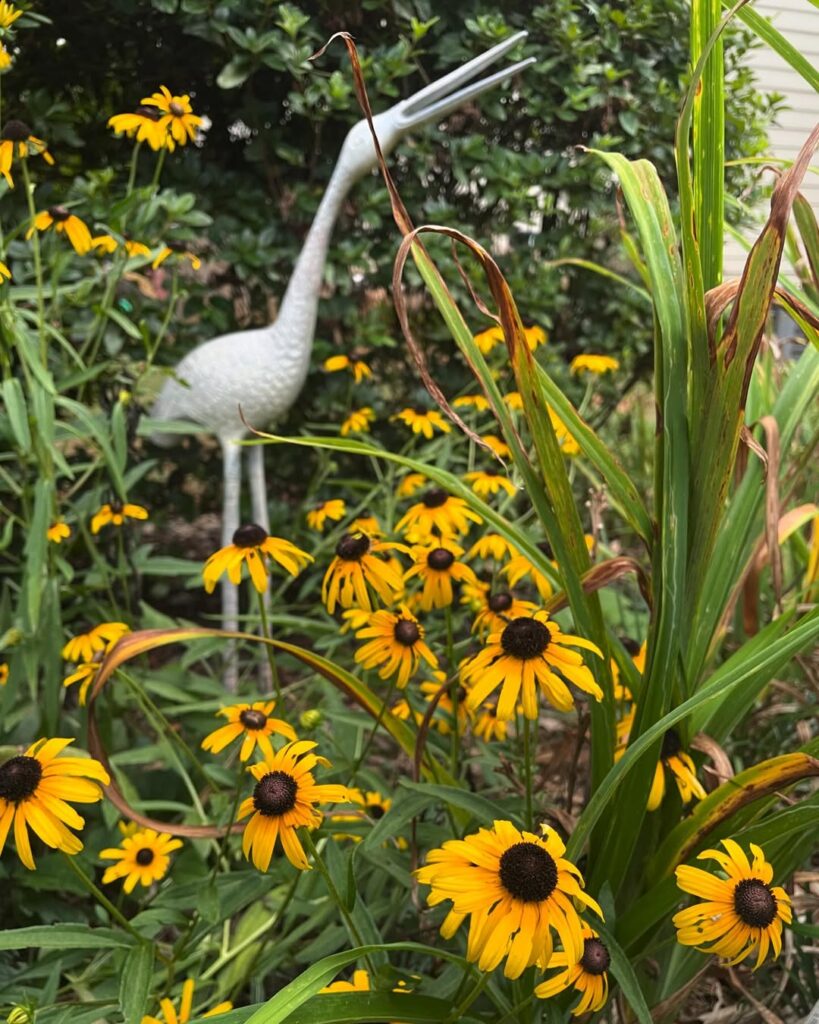
Black-eyed Susan (Rudbeckia hirta) is a versatile native wildflower that brings vibrant color to Delaware gardens with its distinctive 2-3″ flowers featuring bright yellow-orange petals surrounding dark brownish centers. This member of the Asteraceae family grows 1½-2′ tall with greyish-green hairy leaves and can function as an annual, biennial, or short-lived perennial depending on conditions.
The plant produces abundant blooms from early summer through fall, making it an excellent choice for perennial borders, wildflower gardens, and cut flower arrangements. Its drought tolerance once established, combined with minimal maintenance requirements, makes it ideal for naturalized plantings where it pairs beautifully with other natives like purple coneflower and prairie dropseed. The flowers develop into cypsela fruits that contain seeds which mature 3-4 weeks after the bloom period ends.
- Hardiness: Annual, biennial, or short-lived perennial; native to Delaware
- Light: Full sun to part shade
- Water: Drought tolerant once established; benefits from occasional watering
- Soil: Moist, well-drained, modestly fertile soil
- Fertilizer: Low fertility requirements; thrives in modestly fertile conditions
- Pest/Disease Resistance: Generally resistant with minimal issues
- Growth Rate: Moderate; blooms from early summer through fall
New England Aster (Symphyotrichum)

New England Aster brings vibrant late-season color to Delaware gardens with its spectacular display of deep purple flowers and bright yellow centers. This robust native perennial can produce hundreds of daisy-like blooms from August through October, creating stunning fall displays when many other plants are fading. Growing 3-7 feet tall with fuzzy stems and rough, hairy leaves, this herbaceous wildflower serves as both a garden focal point and essential wildlife habitat.
The plant’s numerous ray flowers (45-100 per bloom) and extended flowering period make it particularly valuable for supporting pollinators during late summer and fall. New England Aster works beautifully in meadow gardens, naturalized areas, and as a backdrop for shorter plants, while also providing excellent cut flowers for indoor arrangements. This native wildflower serves as a host plant for Pearl Crescent caterpillars, making it especially valuable for supporting local butterfly populations.
- Hardiness: Zones 3-9, well-suited for Delaware’s climate
- Light: Full sun to partial sun
- Water: Moderate to high moisture tolerance, excellent for rain gardens
- Soil: Adaptable to various soil types including clay, tolerates different conditions
- Fertilizer: Low maintenance, typically does not require supplemental feeding
- Pest/Disease Resistance: Good resistance but requires adequate air circulation to prevent foliar diseases
- Growth Rate: Moderate to fast, reaches 2-4 feet height with 2-3 feet spread
Purple Coneflower
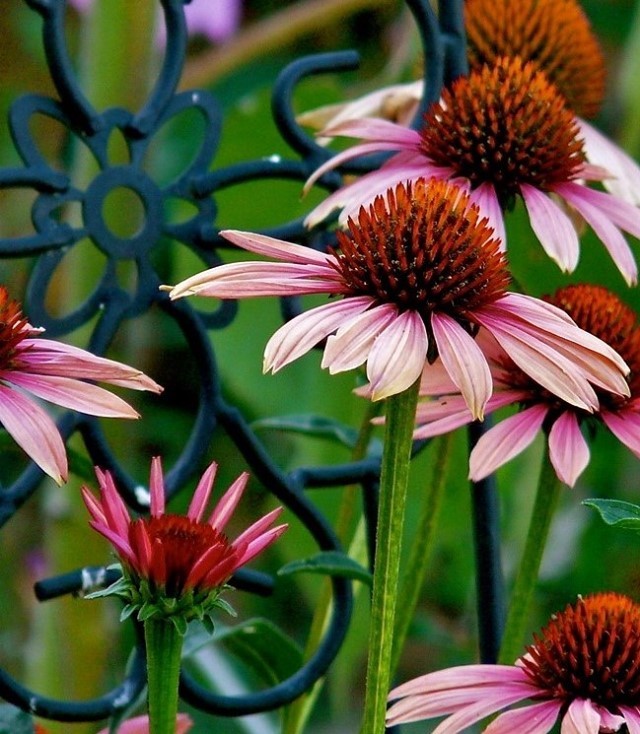
Purple Coneflower (Echinacea purpurea) is a striking native wildflower that brings vibrant color and ecological value to Delaware gardens. This hardy perennial produces large, daisy-like flowers with distinctive lavender-purple petals surrounding spiny, bronze-colored centers that measure 3-6 inches across. Blooming from summer through autumn, Purple Coneflower reaches 2-4 feet tall and serves as a magnet for native pollinators while providing winter seeds for birds like finches.
Beyond its ornamental appeal, Purple Coneflower offers exceptional low-maintenance garden performance and medicinal value. The flowers and roots have been traditionally used for herbal teas and immune-supporting extracts, making it one of North America’s most popular herbal supplements. This deer-resistant perennial thrives in Delaware’s climate, self-seeds readily when allowed, and works beautifully in mass plantings, borders, pollinator gardens, and cut flower arrangements. The plant attracts both butterflies and hummingbirds, making it an excellent choice for wildlife-friendly gardens.
- Hardiness: USDA zones 3-9, well-suited to Delaware’s climate
- Light: Full sun preferred; tolerates filtered shade with reduced flowering
- Water: Drought-tolerant once established; moderate water needs
- Soil: Well-drained soils; tolerates most garden soils and summer heat
- Fertilizer: Low fertilizer requirements; thrives in average garden conditions
- Pest/Disease Resistance: Generally pest-free and disease-resistant; deer resistant
- Growth Rate: Moderate growth rate; herbaceous perennial returning annually
Cardinal Flower

Cardinal Flower (Lobelia cardinalis) is a stunning native Delaware wildflower that produces brilliant scarlet, tubular blooms on tall spikes reaching 2-4 feet. The showy red flowers, which inspired its name from their resemblance to cardinal robes, bloom from bottom to top and are specially adapted to attract ruby-throated hummingbirds as their primary pollinators.
This perennial wildflower thrives in Delaware’s wetland environments, naturally occurring in swamps, marshes, and along stream banks. With lance-shaped dark green leaves forming evergreen rosettes, Cardinal Flower serves as both an ornamental garden specimen and essential wildlife habitat, supporting hummingbirds, butterflies, and native insects while helping stabilize wetland margins. While historically valued by Native Americans for medicinal purposes, it’s important to note that all parts of the plant are toxic in large quantities and can cause symptoms such as nausea and weakness.
- Hardiness: Perennial in Delaware; rosettes remain green through mild winters
- Light: Full sun to partial shade; performs best in filtered light or light shade
- Water: Requires moist to wet soil; excellent for water gardens and rain gardens
- Soil: Thrives in consistently moist wetland conditions; suitable for stream edges
- Fertilizer: No specific requirements as a native wetland species
- Pest/Disease Resistance: Generally resistant; well-adapted native plant
- Growth Rate: Moderate; reaches 1-6 feet in height with 2-4 foot flower spikes
Delaware’s Best Native Trees
Delaware’s diverse native trees range from the towering Eastern White Pine to smaller species like Redbud, offering wildlife support, habitat-specific adaptations, and options for every landscape size. These trees showcase remarkable fall foliage displays, with species like Sugar Maple and Scarlet Oak creating stunning autumn colors throughout the state’s parks and natural areas.
American Holly (Ilex Opaca)
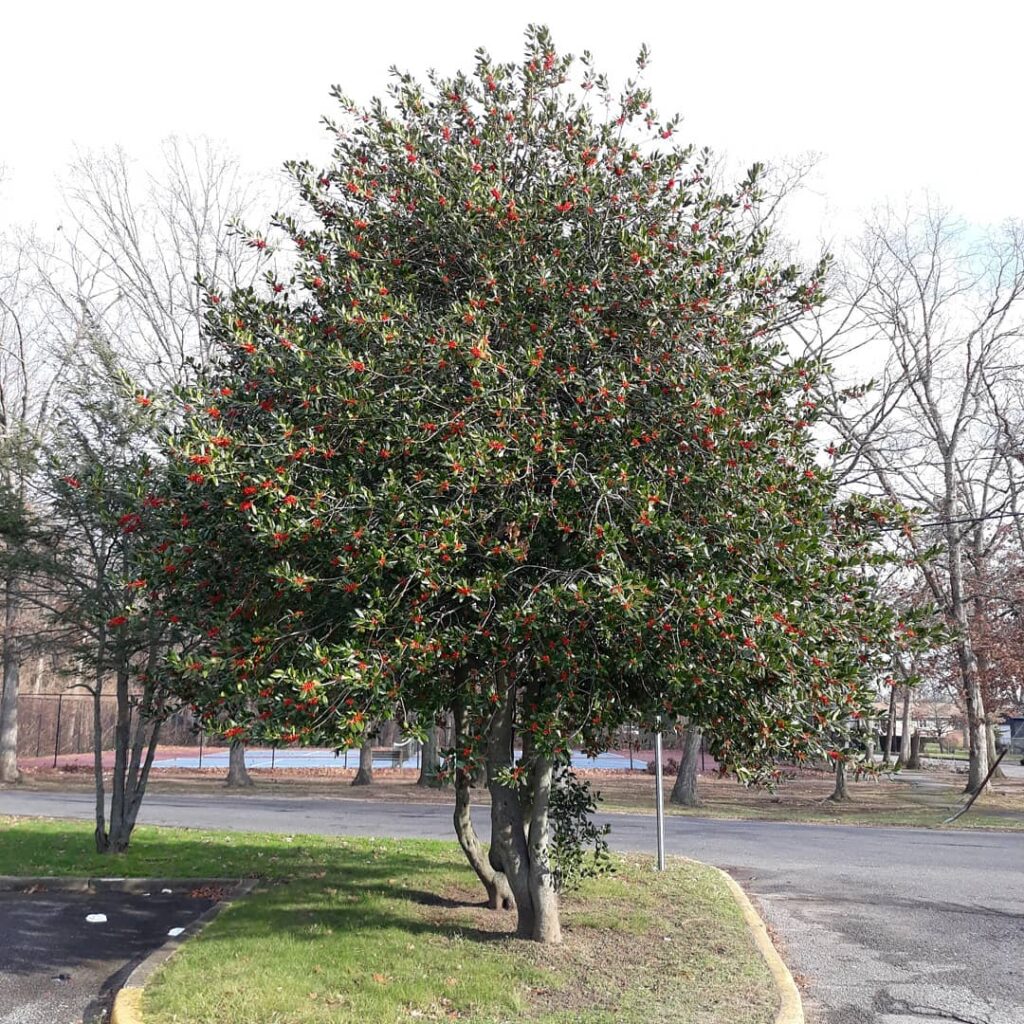
American Holly is Delaware’s official state tree and one of the hardiest broadleaf evergreens, tolerating temperatures as low as -10°F. This attractive native tree grows 25-60 feet tall with distinctive dark green, spiny leaves and smooth gray bark. Female trees produce ornamental red berries that persist through winter, providing essential food for wildlife.
Once a major agricultural crop in Delaware during the 1920s-30s, American Holly remains ecologically valuable for preventing erosion and supporting local wildlife. The tree’s cream-colored wood has been traditionally valued by craftsmen for decorative inlay work on furniture due to its aesthetic appeal and durability. Its adaptability to diverse conditions—from mountain tops to coastal floodplains—makes it an excellent choice for Delaware landscapes, offering year-round evergreen beauty and cultural significance.
- Hardiness: Zones 5-9, tolerates temperatures to -10°F
- Light: Full sun to full shade
- Water: Moderate; prefers moist, well-drained conditions
- Soil: Adaptable to nearly all soil types; prefers slightly acidic, well-drained soils
- Fertilizer: Low requirements; benefits from organic matter
- Pest/Disease Resistance: High resistance to common evergreen pests and diseases
- Growth Rate: Slow to medium
Eastern Redbud (Cercis Canadensis)
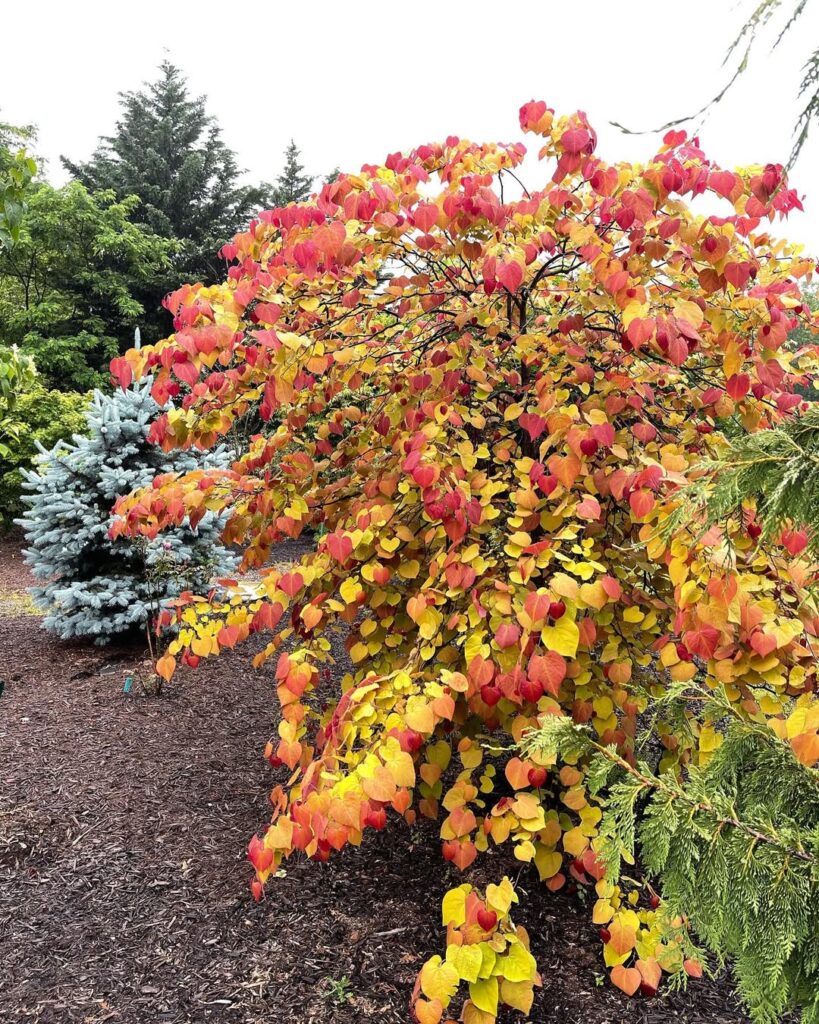
Eastern Redbud is a beloved native tree perfect for Delaware landscapes, typically growing 15-30 feet tall with an attractive rounded, umbrella-like crown. This small deciduous tree creates a spectacular spring display with abundant pink to magenta pea-like flowers that cover the branches and trunk before the heart-shaped leaves emerge. As Oklahoma’s state tree, Eastern Redbud offers excellent ecological value as an early nectar source for pollinators and food source for wildlife, while its compact size makes it ideal for residential gardens and urban plantings. The tree thrives in alkaline soils with pH levels above 7.5, making it well-suited to many Delaware soil conditions.
- Hardiness: USDA zones 4-9
- Light: Full sun to partial shade; flowers best in full sun
- Water: Moderate; drought tolerant once established
- Soil: Well-drained soils; adaptable to sandy, loamy, or clayey conditions
- Fertilizer: Low maintenance; benefits from occasional organic matter
- Pest/Disease Resistance: Generally good; some susceptibility to canker and verticillium wilt
- Growth Rate: Moderate
Tulip Tree (Liriodendron Tulipifera)
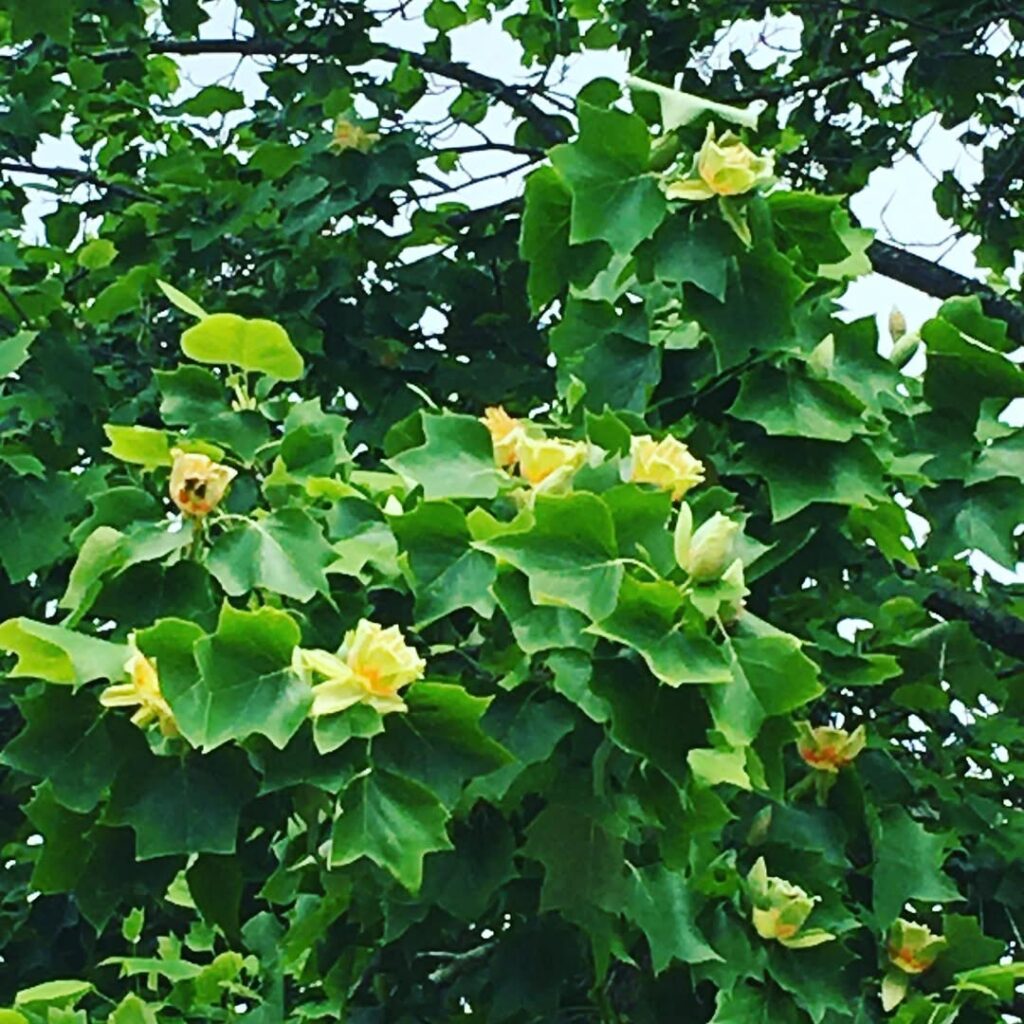
The tulip tree is one of Delaware’s most impressive native trees, capable of reaching heights up to 150 feet with a distinctive pyramidal crown that becomes rounded with age. Despite its common name suggesting a relationship to poplars, it actually belongs to the Magnolia family and features uniquely shaped square leaves that turn golden in fall and striking yellow cup-shaped flowers with orange centers in late spring.
This majestic deciduous tree develops a strong central leader with few lower branches, creating a clean, straight trunk that can extend 50 feet before branching. The distinctive furrowed gray bark provides winter interest, while the tree’s substantial size makes it an excellent shade provider for large landscapes. Though considered high maintenance, the tulip tree offers four seasons of beauty and serves as an important native species for local ecosystems. The tree serves as a larval host for the Eastern Tiger Swallowtail butterfly and Tuliptree silkmoth, making it valuable for supporting native pollinator populations.
- Hardiness: USDA zones 4b-9, well-adapted to Delaware’s climate
- Light: Full sun for ideal growth and development
- Water: High moisture requirements, needs consistent watering
- Soil: Rich, well-draining soil; naturally found in woodland environments
- Fertilizer: Benefits from nutrient-rich soil, may need supplemental feeding
- Pest/Disease Resistance: Generally resistant to deer browsing, moderate disease resistance
- Growth Rate: Fast-growing when conditions are favorable
Red Maple (Acer Rubrum)
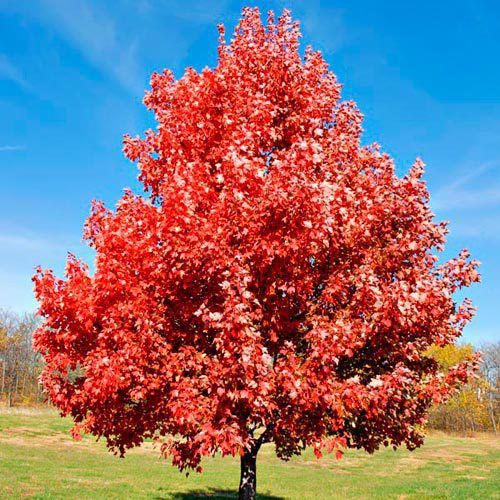
Red maple (Acer rubrum) stands as one of Delaware’s most versatile and valuable native trees, reaching 40-60 feet in cultivation with a graceful rounded crown. This fast-growing deciduous species showcases distinctive red-tinged branches in early spring, followed by brilliant red and orange fall foliage that makes it an exceptional landscape specimen.
The tree’s ecological importance cannot be overstated, providing critical early spring nectar through its March-April blooms that support bumblebees and other pollinators. Its adaptability to various growing conditions, from wet swampy areas to drier landscapes, combined with its shade tolerance and rapid establishment, makes red maple an ideal choice for Delaware gardeners seeking both aesthetic appeal and environmental benefits. The distinctive palmate leaves with their serrated edges create an attractive canopy structure throughout the growing season.
- Hardiness: Native throughout eastern United States, well-suited to Delaware’s climate zones
- Light: Full sun preferred, but adapts well to partial shade conditions
- Water: Prefers wet to moist soils, tolerates swampy conditions and drier landscapes
- Soil: Tolerates many soil types, performs best in acidic soils
- Fertilizer: No special fertilizer requirements as a native species
- Pest/Disease Resistance: No serious disease or insect problems
- Growth Rate: Fast-growing, especially in youth for quick landscape establishment
American Beech (Fagus Grandifolia)
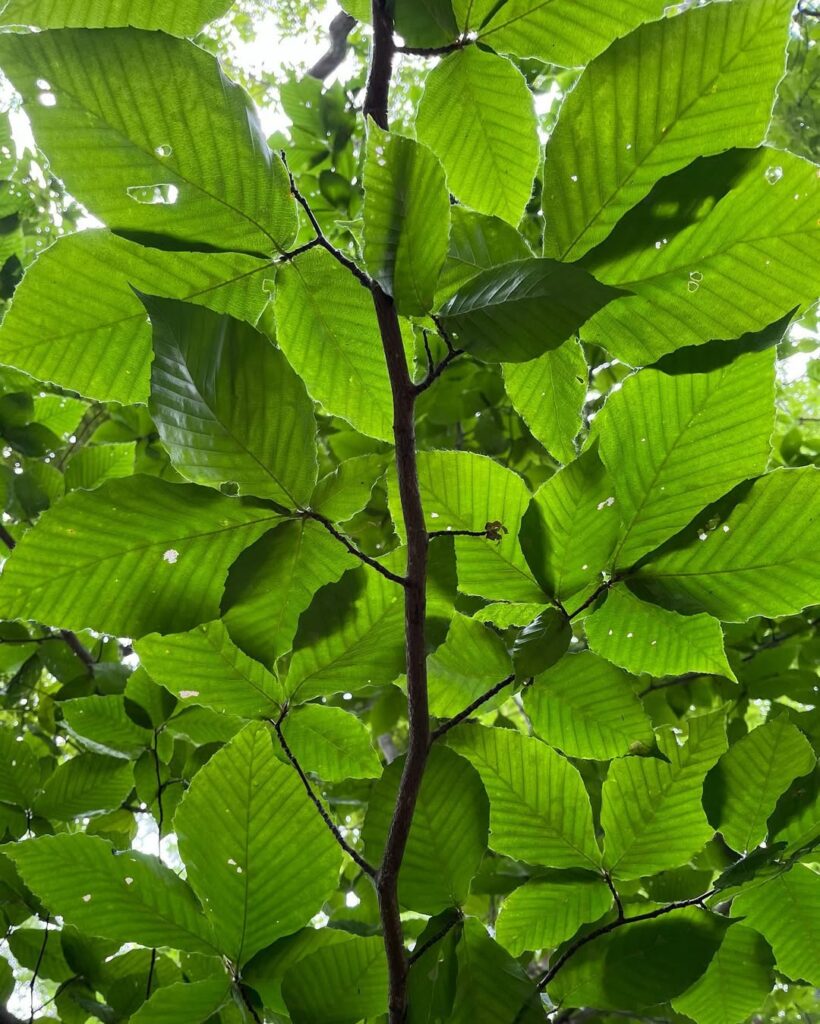
The American Beech is a magnificent native tree that can reach 60-80 feet tall with a distinctive smooth, silver-gray bark and rounded, spreading crown. This long-lived species features dark green leaves that turn golden bronze in fall and distinctive cigar-shaped winter buds. Native to North America and well-suited to Delaware’s climate, it produces edible beechnuts and serves as important wildlife habitat.
As a specimen tree, American Beech creates an impressive focal point in larger landscapes. Its shallow root system makes underplanting challenging, so mulching is recommended. The tree retains tan leaves through winter and can live over 300 years in favorable conditions. This shade-tolerant species typically establishes in the final succession stages of forests, often growing alongside sugar maple.
- Hardiness: USDA zones 3-9
- Light: Full sun to shade
- Water: Moist but well-drained; intolerant of poor drainage
- Soil: Deep, organic, well-draining soil
- Fertilizer: Not specified; thrives in organic-rich soil
- Pest/Disease Resistance: Not specified
- Growth Rate: Not specified
Delaware’s Native Shrub Standouts
Delaware’s native shrubs offer diverse solutions for landscaping challenges, from erosion control and wildlife habitat to seasonal color and fragrant blooms across various soil and light conditions. These adaptable plants thrive in the state’s predominant Middle Atlantic Coastal Plain ecoregion, which features the flat terrain and well-drained sandy soils found throughout most of Delaware.
Spicebush (Lindera Benzoin)
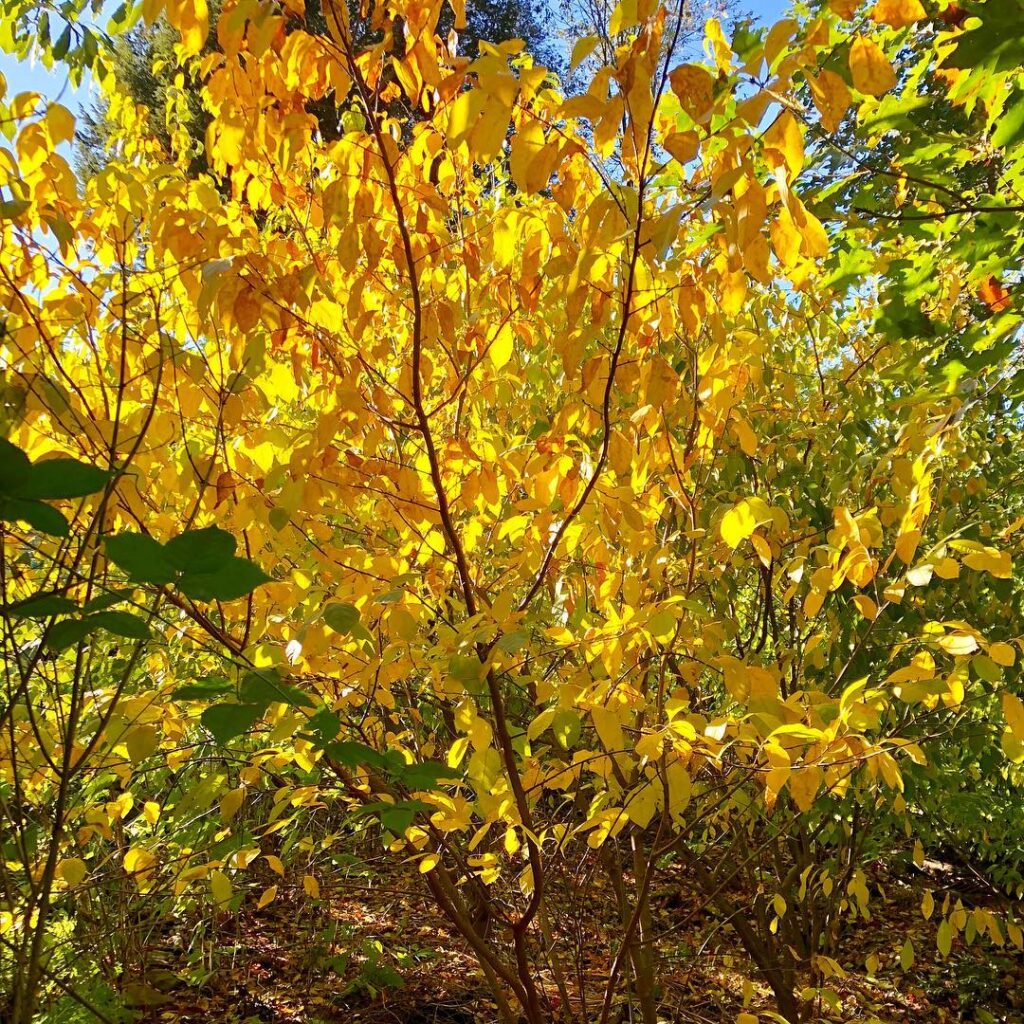
Spicebush (Lindera benzoin) stands out as one of Delaware’s premier native shrubs, thriving in the state’s moist forests and wetland margins. This fast-growing deciduous shrub produces fragrant white to yellow blooms in April and emits a distinctive spicy aroma when its twigs or leaves are crushed.
Beyond its ornamental value, spicebush plays an essential ecological role as the host plant for the spicebush swallowtail butterfly and produces berries that feed local wildlife. The shrub transforms in autumn with leaves turning golden-yellow before dropping. Its remarkable adaptability to various light and moisture conditions, combined with excellent deer resistance, makes it an ideal choice for naturalizing woodland edges, rain gardens, and native plant landscapes throughout Delaware.
- Hardiness: Native to Delaware and eastern US regions
- Light: Full sun to full shade (performs best with some sunlight exposure)
- Water: Medium water requirements; tolerates dry, moist, or wet conditions
- Soil: Prefers moist, sandy, well-drained soils; adapts to various soil types including peaty soils
- Fertilizer: Low maintenance; no special fertilizer requirements
- Pest/Disease Resistance: Excellent; no serious disease or insect problems
- Growth Rate: Fast-growing
Elderberry (Sambucus Canadensis)
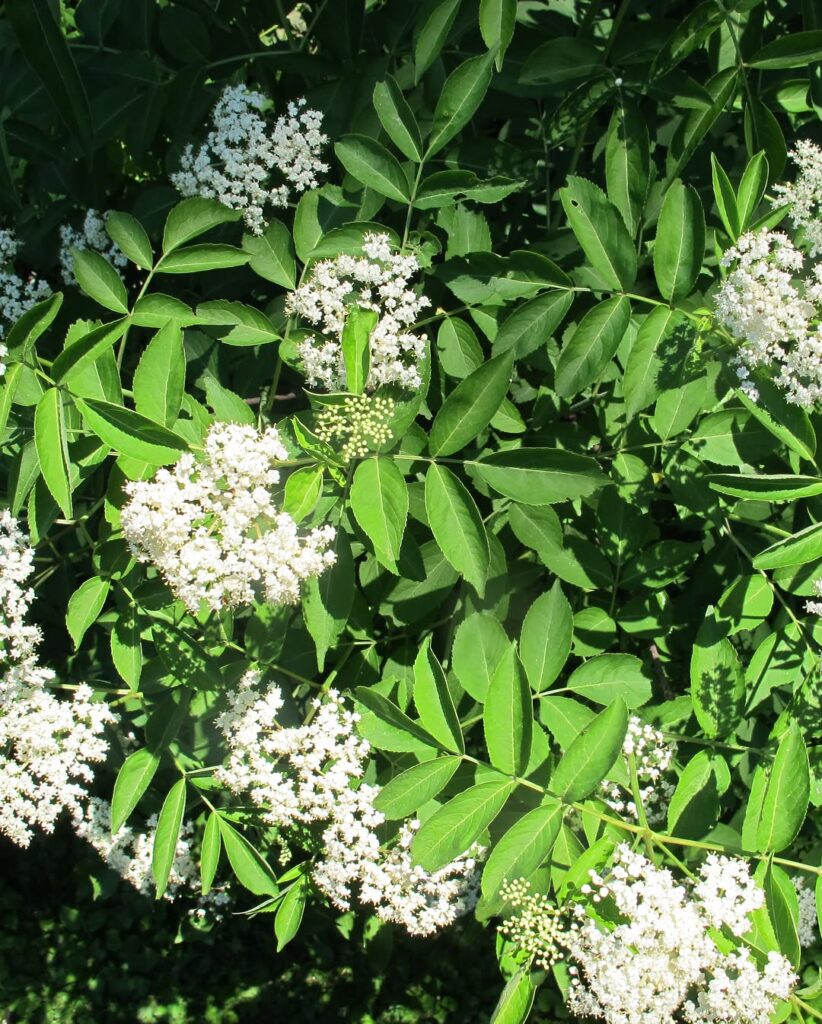
Elderberry (Sambucus canadensis) is a versatile native shrub that serves as an excellent addition to Delaware landscapes. This deciduous plant grows 4-15 feet tall with a graceful, arching form featuring compound leaves and spectacular clusters of white flowers from May to June. The subsequent dark berries ripen from July through October, providing both wildlife value and potential human use.
This hardy shrub thrives in Delaware’s climate and demonstrates remarkable adaptability to various growing conditions. Elderberry particularly excels in moist environments where many other fruiting plants struggle, making it unique among northern fruit-bearing species. The flowers can be transformed into elderberry wine and cordials, while the berries make excellent jellies and medicinal syrups.
- Hardiness: Native to eastern North America, well-suited for Delaware’s climate zones
- Light: Full sun preferred, tolerates partial shade
- Water: Thrives in moist, well-drained conditions; tolerates damp to dry soils
- Soil: Adaptable to various soil types including clay; prefers pH 5.5-6.5
- Fertilizer: Low maintenance requirements as established native species
- Pest/Disease Resistance: Generally resistant; tolerates atmospheric pollution
- Growth Rate: Fast-growing, reaches full production quickly after establishment
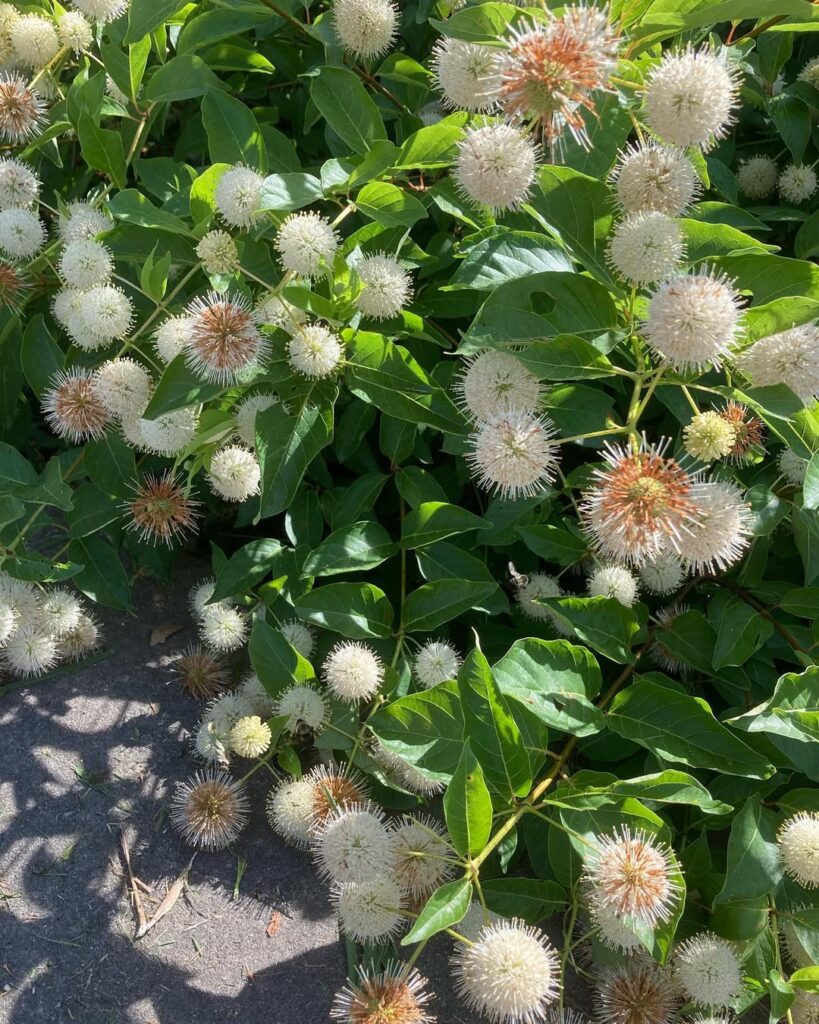
Buttonbush (Cephalanthus occidentalis) is a distinctive native shrub that thrives in Delaware’s wetland environments. This fast-growing, multi-stemmed plant produces unique globe-shaped clusters of fragrant white flowers from June through September, creating a pincushion-like appearance that attracts numerous pollinators. Growing 6-12 feet tall with an irregular crown and twisted branches, buttonbush forms dense thickets through root suckering.
This wetland specialist excels in consistently moist to wet conditions, making it invaluable for rain gardens, streambank restoration, and stormwater management. The shrub provides excellent wildlife value, supporting butterflies, bees, and various bird species while serving as a larval host for silkmoths. Its reddish-brown fruits persist through winter, extending seasonal interest. The plant features dark green, glossy leaves that can grow up to 8 inches long, providing an attractive backdrop to the showy blooms.
- Hardiness: Zones 5-9
- Light: Full sun to partial sun; flowering diminishes in heavy shade
- Water: Consistently moist to wet; tolerates standing water up to 3 feet
- Soil: Adaptable to various soil types except dry soils; tolerates compaction
- Fertilizer: None required; thrives in natural wetland conditions
- Pest/Disease Resistance: Generally resistant; moderately deer-resistant
- Growth Rate: Fast-growing and short-lived
Winterberry Holly (Ilex Verticillata)
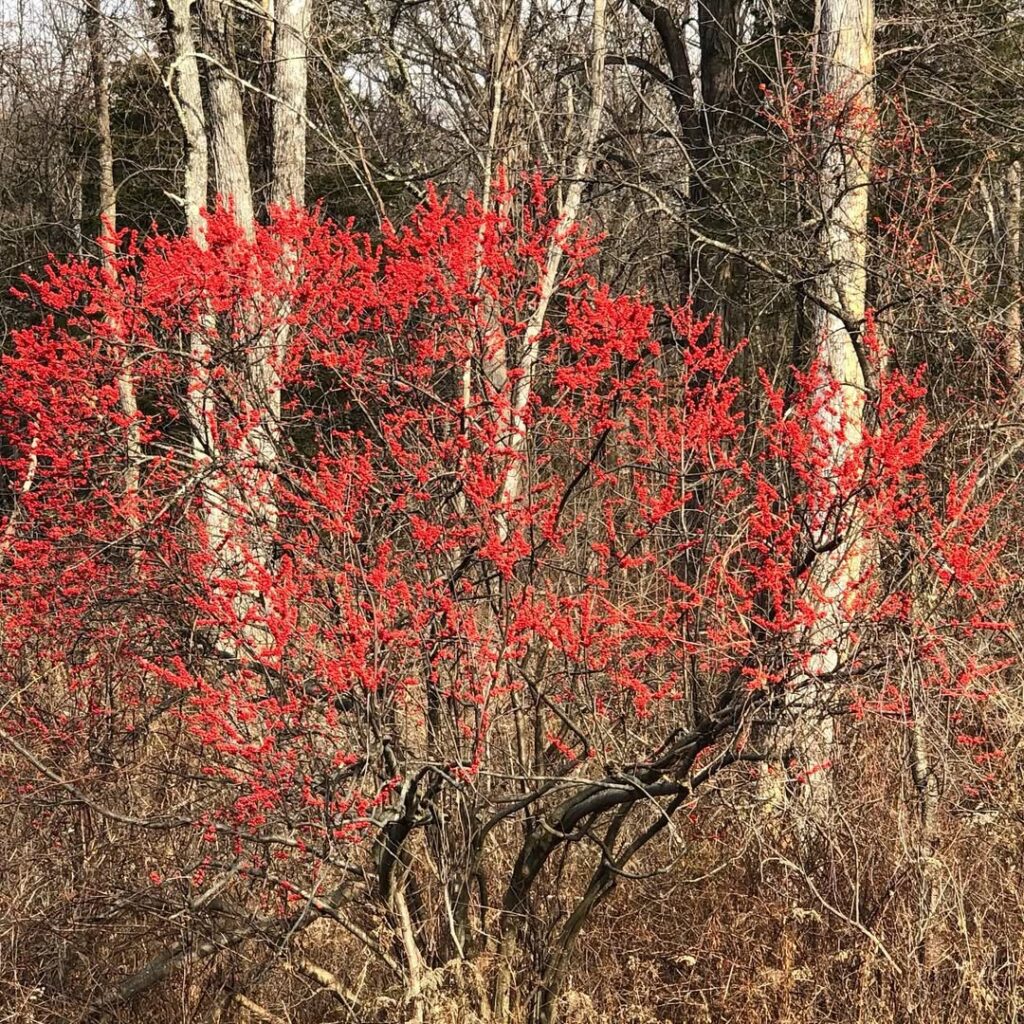
Winterberry Holly is a native deciduous shrub that creates stunning winter landscapes with its brilliant red berries persisting after leaves drop. Growing 3-16 feet tall with an upright oval habit, this Delaware native produces small white flowers followed by vibrant 6-8mm berries that provide critical winter food for over 48 bird species and small mammals. The glossy serrated leaves turn yellow in fall before revealing the spectacular berry display that makes this shrub invaluable for winter interest.
This adaptable native thrives in riparian areas and wet sites where other plants struggle, making it excellent for rain gardens and wetland restoration. As a dioecious species, both male and female plants are needed for berry production, and the shrub naturally spreads to form colonies in moist conditions while remaining compact in drier soils. The plant also serves as a moth host for the pawpaw sphinx, enhancing biodiversity in garden settings.
- Hardiness: Zones 3-9
- Light: Partial sun to full shade
- Water: Moist to wet conditions preferred
- Soil: Highly acidic, tolerates poor drainage and problem soils
- Fertilizer: Low maintenance, minimal fertilizer needs
- Pest/Disease Resistance: Excellent resistance to most pests and diseases
- Growth Rate: Moderate, spreads naturally through suckers to form thickets
Serviceberry (Amelanchier Canadensis)
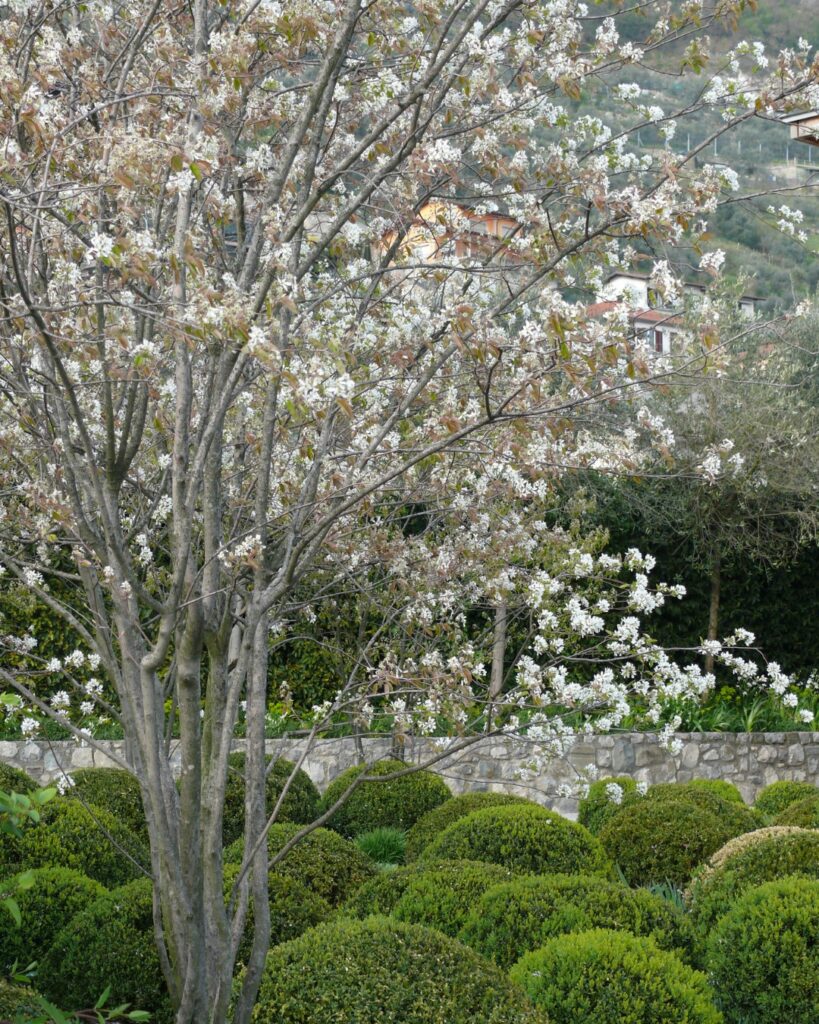
Serviceberry (Amelanchier canadensis) is a versatile native deciduous shrub or small tree that brings exceptional four-season beauty to Delaware landscapes. This adaptable plant produces stunning white flowers in early spring before leaves emerge, followed by edible crimson fruits that attract wildlife. Its brilliant orange-red fall foliage provides spectacular autumn color, while its graceful multi-stemmed form adds structural interest year-round.
As a member of the Rose family, Serviceberry supports numerous native butterfly and moth species, making it an excellent choice for wildlife gardens. The plant’s common name “Shadbush” comes from its blooming period, which coincides with the annual shad fish runs. Growing 6-20 feet tall with an open, delicate crown, this low-maintenance native thrives throughout Delaware’s varied landscapes. The plant can be easily propagated using hardwood or softwood cuttings for gardeners interested in expanding their plantings.
- Hardiness: USDA zones 4-9
- Light: Full sun to partial shade
- Water: Moderate; drought tolerant once established, prefers consistent moisture
- Soil: Adaptable to various soil types including clay and sand; prefers moist, well-drained, acidic soils with pH 5.5-7.5
- Fertilizer: Minimal requirements; benefits from organic matter
- Pest/Disease Resistance: Susceptible to various issues but damage is typically cosmetic rather than fatal
- Growth Rate: Moderate
Selecting the Right Native Plants for Your Garden
Why do some native plants thrive in one Delaware garden while struggling just yards away in a neighbor’s landscape? The answer lies in plant compatibility with specific site conditions. Your soil’s pH, drainage, and light exposure determine success more than wishful thinking.
Start by testing soil pH and observing sunlight patterns throughout the day. Match moisture-loving species like Blue Flag Iris to wet areas, while drought-tolerant Butterfly Milkweed suits sandy, well-drained spots. Consider your ecoregion’s challenges—coastal gardens need salt-tolerant varieties.
Smart selection reduces garden maintenance considerably. Native plants adapted to your specific conditions require less water, fertilizer, and pest control than mismatched species. These plantings also support local wildlife by providing essential food sources and nesting habitats for native birds and insects.
Frequently Asked Questions
How Do I Obtain Seeds or Seedlings of Native Delaware Plants?
You can obtain Delaware native plant seeds through local nurseries like Izel Native Plants, conservation group sales, or seed swaps with gardening clubs. Extension offices maintain supplier lists and host events featuring regionally appropriate species.
What Time of Year Should I Plant Native Species in Delaware?
You should focus on spring planting from February 15 to April 30 or fall planting from August 15 to October 31. These periods offer natural rainfall, cooler temperatures, and ideal conditions for establishing native Delaware species successfully.
Do Native Delaware Plants Require Special Fertilizers or Soil Amendments?
Picture thriving wildflowers in untouched meadows—that’s how native Delaware plants naturally flourish. You don’t need organic fertilizers for native plant care since they’re perfectly adapted to local soils and excessive amendments actually harm their growth.
How Long Does It Take for Native Plants to Establish in Delaware?
You’ll see native Delaware plants establish over different establishment timelines depending on species and growth conditions. Most require one to three years, with cool-season grasses establishing faster than warm-season varieties.
Are There Any Native Plant Societies or Groups in Delaware?
You’ll discover Delaware’s surprisingly thriving native plant organizations aren’t just for serious botanists! The Delaware Native Plant Society and local gardening clubs offer resources, plant sales, and community connections for enthusiasts at all levels.
